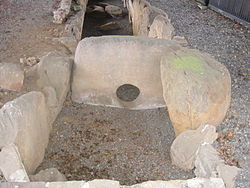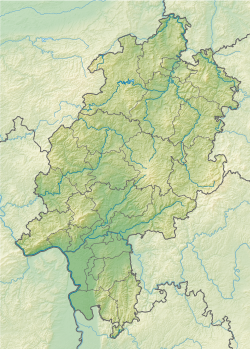Züschen stone chamber grave
| Züschen stone chamber grave | ||
|---|---|---|
|
Perforated stone and antechamber of the gallery grave of Züschen |
||
|
|
||
| Coordinates | 51 ° 10 '26 " N , 9 ° 14' 26" E | |
| place | Fritzlar OT Züschen , Hesse , Germany | |
| Emergence | 3500 to 2800 BC Chr. | |
The stone chamber grave of Züschen , also known as the stone box, is a prehistoric megalithic complex that lies in the field between the Fritzlar districts of Züschen and Lohne in northern Hesse . It is a gallery grave , one of the most important examples of its kind, and dates from the 4th to 3rd millennium BC. Because of its incised symbols it occupies a special position among the megalithic systems of the Züschen type of the Wartberg culture .
Discovery and excavation
The miller Schmalz from Züschen had come across a row of sandstones that prevented him from tilling the field years before the actual discovery of the grave. He moved the stones for the time being and contented himself with having some of the slabs worked off the upper edge. In the spring of 1894 the obstacles were to be removed for good. The inspector Rudolf Gelpke from the Garvensburg , which is under construction in Züschen , noticed the occurrence of sandstone on the basalt knoll as unusual. After a detailed inspection, he came to the conclusion that the two rows of vertical, regular slabs must have been a prehistoric find. Gelpke enforced that the owner of the field only let the earth lift off at both ends. Shards and bones came to light. Thereupon the owner of the Garvensburg, Wilhelm Garvens , was informed, who in turn informed an archaeologist , the Baron Felix von und zu Gilsa . He inspected the find, whereupon the grave was uncovered under the supervision of the former director of the Staatliche Museen Kassel, Johannes Boehlau . Follow-up examinations were carried out by O. Uenze from the Office for Soil Antiquities in Marburg in 1939 and 1949.
The structure of the stone chamber grave
The rectangular burial chamber sunk into the ground is 20 m long and 3.50 m wide. The complex is made up of rectangular sandstone slabs that cannot be found on this side of the Elbe stream . The long walls consist of two rows of 12 stones each, one of which is missing. The narrow sides each consist of a plate.
A closing plate separates the actual burial chamber from a small anteroom with a length of 2.50 m. This plate has a circular opening in the middle, the so-called soul hole, 50 cm in diameter, which can be interpreted as an entrance and a door between the living and the dead for the sacrifices taking place in the anteroom. It cannot be proven whether the opening was closed, as is the case with comparable French systems. The floor of the anteroom is made of clay that has been trodden like a drum. Remnants of a plate lying inside the grave document the original cover of the complex. The finding of foreign stones suggests a hill filling.
Building material
The area around the grave, which is part of the Hessian Basin, is characterized by red sandstone surfaces pierced by basalt domes. 25 stone slabs were examined. The building material used is the Wilhelmshausen layers of the Solling series, which can be assigned to the Middle Buntsandstein. The layers are in several outcrops north and south of the plant. Due to the short distance and the nature of the layers for mining under Neolithic conditions, two locations are possible. The determined distances are 1300 m to the north and 1000 m to the south. Since the transport route from the northern outcrop to the grave is less steep, this is the more likely one despite the somewhat greater distance. Until a few years ago, red sandstone was mined north of the grave, so that the layers here are exposed to a great depth. During the Neolithic, it can be assumed that it was taken from the surface. Natural outcrops can be found south of the system. The layers on the surface are badly weathered and show cracks, which the northern outcrop will also have shown before modern exploitation. The Wilhelmshausen layers are suitable for extracting flat building material. The layers or benches are naturally separated vertically and horizontally by fracture systems and layers and can be dismantled with simple means. The shape of the workpiece was determined by these natural joints. Due to the sandy structure, the stones are relatively soft and well suited for processing the surfaces. The creation of the circular soul hole in the perforated door stone and the decoration with incised drawings presented no difficulty.
The finds
The rubble was riddled with numerous human bones. Since only 27 skeletal remains were found at the bottom of the grave complex and the bones were strongly mixed up and were no longer in a bond and in a row, it can be assumed that the original number of people buried was much greater. The early destruction of the tomb and the ceiling panels must have occurred before the 10th to 9th centuries BC. . Be done BC, since one the remains of an urn temporal Secondary burial place. Charcoal and ashes were found in various places, especially in the bone fragments on the perforated door stone and on the southwestern end plate. However, the human bones show no signs of burn. A coherent layer of ash was discovered in the middle of the antechamber.
Grave goods
Most findings come most likely from the main chamber and thus were the dead of burial added . In addition to the skeletal remains and cattle bones , as the grave had been destroyed at an early stage, very little pottery , some stone and bone tools, an earthen cup and a flask with a collar from the Nordic funnel-shaped culture were found. Vegetable oils or sulfur , which were used as medicinal products , were probably kept in this. In addition, a fragment of a cup was found that is similar to the finds in the grave of Lohra . The so-called giant beaker probably comes from a subsequent burial. Knife blades and sickle inserts made from flint were found, as well as small trapezoidal axes made from Wieda slate . A chisel , point and arrowhead were found on bone tools.
The rock carvings
The incised signs are among the impressive finds from the excavation. With a possibly early metal device (?) Punctiform impacts were lined up in lines. A recurring sign is a line with an attached, open semicircle, which is interpreted as depicting cattle. Usually two cattle are connected by a line with two emphasized end points. The representation could be a plow. More rarely, the signs are connected by a yoke with a drawbar to form carts. It can be assumed that the depictions of cattle have no relation to one another. It is probably a summation of individual characters, which can be proven by the overlap. Should a cart really be depicted, it would be one of the oldest wheel depictions in human history.
Furthermore, a face can be seen on stone B2. Based on comparisons with other representations in France, this face is interpreted as an image of the great goddess or dolmen goddess, whose attribute is a cart pulled by cattle.
Incised drawings that are comparable to carts of cattle include the corresponding but much younger characters on rocks in Valcamonica near Capo di Ponte in northern Italy and in the Ligurian Alps of Mont Bégo , France . The symbols could reflect the ideas of a Stone Age religion.
A replica of the grave complex is in the Hessian State Museum in Kassel .
The second Züschen grave
Another grave was located 150 meters northwest of the stone chamber grave. This was found completely destroyed in 1984, remains in the area are no longer visible today. The grave was excavated in 1949 by O. Uenze from the Office for Soil Antiquities in Marburg. It was 12 m long and 2.5 m wide and sunk into the ground, the wall panels were made of sandstone (with a limestone slab). The finds consisted of “numerous” human bones (not documented), as additions were found a few shards, stone tools (including an ax, flint blades, a flint ax, a cross-edged arrowhead made of silica slate) and cattle bones.
See also
literature
- Dietrich Evers (ed.): The oldest car pictures in Europe. Engravings in the stone chamber grave of Züschen in Northern Hesse - attempt at an interpretation . Gutenberg, Melsungen 1988, OCLC 475317755 (For the exhibition in the Hessisches Landesmuseum Kassel May 8 - July 24, 1988).
- Irene Kappel: The stone chamber grave near Züschen - monument of European importance in Northern Hesse. Leaflet to the Neolithic burial site in the Lohne district, Fritzlar town, Schwalm-Eder district . In: State Office for the Preservation of Monuments Hesse (Hrsg.): Archaeological monuments in Hesse . 2nd supplementary edition. Issue 22. Wiesbaden 1989, ISBN 3-89822-022-2 .
- Irene Kappel: Stone chamber graves and menhirs in Northern Hesse, Kassel 1989a
- Kerstin Schierhold: The building site for a grave - use of raw materials and space in the Hessian-Westphalian megalithic . In: Varia neolithica . tape VI . Langenweißbach 2009.
- Waldraut Schrickel: Western European elements in the Neolithic grave construction of Central Germany and the gallery graves of West Germany and their inventories . In: Contributions to the prehistoric and early historical archeology of the Mediterranean cultural area . tape 4 . Habelt, Bonn 1966, DNB 458885762 .
Web links
- Züschen Gallery Grave (The Megalithic Portal)
- View of the painting from the stone chamber grave in Züschen, painted by the North Hessian native painter Burkhard Niebert
- Museum Fritzlar ( Memento from July 19, 2011 in the Internet Archive )
- Project page "Steinkammergrab Züschen I" of the WWU Münster
- The gallery grave Züschen on Grosssteingraeber.de
Individual evidence
- ↑ cf. Kappel 1989a, p. 16f.
- ↑ Irene Kappel: Stone chamber graves and menhirs in Northern Hesse. Edited by State Art Collections Kassel. Kassel 1978, pp. 6-8, 11-23.
- ↑ Irene Kappel: Stone chamber graves and menhirs in Northern Hesse . Guide to North Hessian Prehistory and Early History 5. Published by the Staatliche Kunstsammlungen Kassel 1978. p. 24.



